All About Visiting Yellowstone in August
The benefits, drawbacks, activities and other features of visiting Yellowstone in August.
Updated 10/26/22
August is a great time to visit Yellowstone National Park. The weather is lovely, the wildlife is plentiful, and there is so much to explore. There are many benefits to visiting Yellowstone in August, as well as some drawbacks. Below we categorized the most common “when to go” questions to make it easy to figure out if this the best time for you to visit.
Benefits of Visiting in August
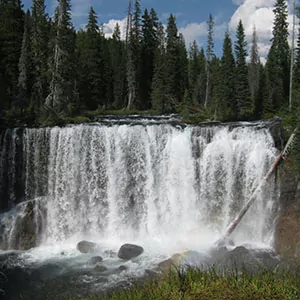 The biggest benefit of visiting Yellowstone in August is the accessibility of the trails. It is a perfect time to strap on the hiking boots now that the snow has melted, giving visitors over 1,000 miles of trail to choose from. Preview hike ideas from our hand-picked list of the best trails in Yellowstone.
The biggest benefit of visiting Yellowstone in August is the accessibility of the trails. It is a perfect time to strap on the hiking boots now that the snow has melted, giving visitors over 1,000 miles of trail to choose from. Preview hike ideas from our hand-picked list of the best trails in Yellowstone.
Another benefit of visiting in August is the wildlife viewing. Elk and bison are beginning the rut, their mating season, which comes with males tussling in the valleys, large herds congregating together, and the characteristic elk bugle that echos off the mountains. Much of the park’s other wildlife is active during this time as bears forage on berries and young elk and bison if they can get it, and waterfowl and members of the weasel family frolic in the park’s many rivers and lakes. Wildlife is one of the main reasons that some visitors come to Yellowstone as the park has the highest concentration of mammals in the lower 48 states with a fantastic predator-prey complex.
In addition to these, fishing season is still open in Yellowstone and recreational angers can get licenses at any visitor center or one of the fly fishing shops just outside the park. In contrast to earlier in the season, August’s weather is more predictable and suitable for outdoor activities with warmth during the day, cool evenings, and small chances of rain. Prepare by bringing a rain jacket and a warmer layer for the evenings, especially if you’re camping.
Drawbacks of Visiting in August
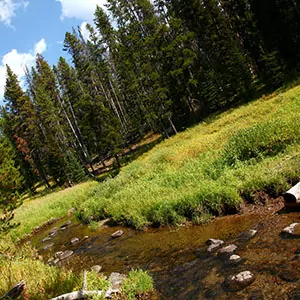
One of the biggest drawbacks to visiting in August is the crowds—on average, 4 million people visit Yellowstone in July alone. This means waiting in long lines for services, extended drives around the park due to increased traffic, and large crowds near famous sights. Additional delays in driving can be caused by unexpected events such as a car accident or wildlife on the side of the road, potentially backing up traffic for hours. While the park has two loops and there are multiple ways to get to destinations, once you pick a route you have to finish the loop, so these bear jams (as the rangers call them) can drastically mess up a schedule. It’s best to remain flexible and to have realistic expectations about what you will be able to get done in one day.
As a result of the higher density of crowds, accommodations are much more difficult to find and are priced higher compared to the off-season. Yellowstone accommodations both in and outside the park fill a year in advance and are often expensive. If you’re looking to plan a last-minute trip, you’ll be lucky to find a place to stay at all, and if you do, will probably have to shell out peak season rates.
Another drawback of August is that, while the wildlife is very active, some of the more elusive animals such as wolves, mountain lines, bobcats, and others will remain in the high country to stay away from the crowds and the warmer temperatures. While it is not impossible to see wolves in the Lamar or Hayden Valleys, it is much less likely to see them in August compared to winter or one of the shoulder seasons.
Overall, however, August is one of the best times to visit the park; the main drawback is that everyone else knows that it’s one of the best times to visit the park. If you can only make it to Yellowstone in the summer, here are some tips to avoid the congestion:
1. Go on a hike: taking just one step on a trail eliminates a lot of the crowds, and Yellowstone has over 1,000 miles of trails to choose from.
2. Get an early start: the earlier you start, the more of the park you’ll have to yourself.
3. Have a plan, but also be flexible: know where you want to go before you begin driving, but also enjoy the scenery if you get stuck in a bison jam.
4. Avoid the busy eateries at mealtimes: there are plenty of beautiful places in the park that make perfect picnic spots.
5. Find an off-the-beaten-path hike: read our list of favorite trails in Yellowstone National Park.
Things To Do In August
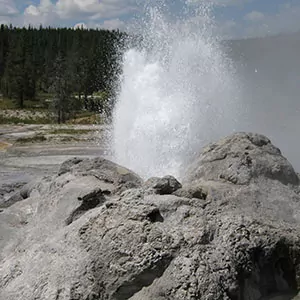 Hiking and backpacking are some of the best things to do in August. There are great hiking options around many of the famous sights such as Old Faithful and Grand Prismatic Spring that allow you to escape some of the crowds while enjoying immersing yourself in nature. These trails often bring you to overlooks where you can see the famous sights from a different angle and hopefully with fewer people in front of you. There is great hiking in the area around the Grand Canyon of Yellowstone as well as Yellowstone Lake in the southern part of the park. Backpacking options are abundant and getting into the backcountry will allow visitors to experience more solitude and quiet this time of year. There are over 1,000 miles of trails in the park, so your options seem to be endless. You can read about how to get backcountry permits or join a guided trip. Llama treks can lighten your load in the backcountry and provide visitors with a novel experience.
Hiking and backpacking are some of the best things to do in August. There are great hiking options around many of the famous sights such as Old Faithful and Grand Prismatic Spring that allow you to escape some of the crowds while enjoying immersing yourself in nature. These trails often bring you to overlooks where you can see the famous sights from a different angle and hopefully with fewer people in front of you. There is great hiking in the area around the Grand Canyon of Yellowstone as well as Yellowstone Lake in the southern part of the park. Backpacking options are abundant and getting into the backcountry will allow visitors to experience more solitude and quiet this time of year. There are over 1,000 miles of trails in the park, so your options seem to be endless. You can read about how to get backcountry permits or join a guided trip. Llama treks can lighten your load in the backcountry and provide visitors with a novel experience.
August is perfect for the water—whether it be fishing, boating, or kayaking. For fishing, the best locations are the Gardner River, Lamar River, Slough Creek, and Soda Butte Creek. Permits are required for any fishing in the park and can be purchased at any visitor center or fly store outside Yellowstone. Boats are available to rent on Yellowstone Lake at Bridge Bay and guided kayak tours on Yellowstone Lake are available at Grant Village. You can check out our list of best tours in Yellowstone to find the tour that fits your interests.
Wildlife and landscape photography are also very popular options in the park, as there is beauty everywhere you turn. Grizzly bears and bison are not uncommon sites in the park, and you will almost definitely have a chance to photograph some of these animals by just driving through the different sections of Yellowstone. Night sky photography is also a fun option since the nights are warmer and this allows you to escape some of the crowds. It is especially neat if you can capture some of the parts of hydrothermal features in the foreground of your shot of the Milky Way.
There are also bus tours and white water rafting around the park that allow you to see the area from a different perspective. If the higher action sports aren’t your thing, any of the visitor centers and museums in the park are worth a visit as they provide interpretive information and practical information about where to go based on your interests
Things to see in august
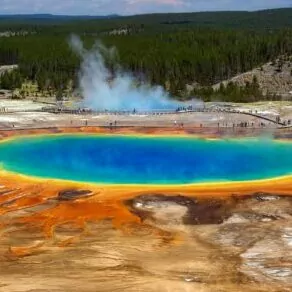
There are nearly as many things to see in August as there are to do, and if you read the previous section you know that’s a lot. We’ve come up with just a few sights that we think shouldn’t be missed in August but make sure to do your own research about what specifically piques your interest in the park.
Old Faithful: Yellowstone’s unofficial icon, this geyser is a must-see for anyone visiting the park, no matter how many times you’ve seen it before. While most geysers erupt infrequently and unpredictably, Old Faithful has lived up to its name and has varied in eruptions only 30 minutes in the last 30 years. The National Park Service predicts eruptions each day, and visitors are continually wowed by the geyser spewing hundreds of gallons of boiling water straight up into the air.
Yellowstone Lake: Far south in Yellowstone National Park lies Yellowstone Lake. The largest Alpine Lake in the country, it has over 100 miles of Shoreline, all of which are packed with wildlife, hydrothermal features, and hiking trails. With a village area and visitor center along with boating and fishing activities on the lake, this area is not to be missed by visitors in August.
Grand Prismatic Spring: Perhaps the most famous hot spring in the park, Grand Prismatic Spring is well known for its brilliant colors and billows of steam rising from its surface. The area has a boardwalk along the edge of the spring and also a short hiking trail that leads to an overlook (see image left) to get a better look at the colors. The blue, green, orange, and yellow in the spring are caused by billions of microorganisms that can only live in very specific temperatures. When the water cools by a degree or two away from the center, a new microorganism– and thus a new color– takes over.
The Rut: The mating season of elk and bison, call the rut, is not to be missed if you’re visiting in late summer or early fall. Males of both species can be seen tussling with interlocking antlers, fighting for the right to mate. While elk form harems of females in small herds of 10 to 30, bison gather in large herds with both male and female together, as males will take females away from the herd one by one to mate. The rut also brings with it the unmistakable elk bugle, that ranges from a high whistle to a low growling sound.
Grand Canyon of Yellowstone: Home to some of the best hiking in the park, the Grand Canyon of Yellowstone will capture your curiosity and bring you amazement. With the upper and lower Yellowstone Falls cascading from within the canyon and steam vents along the side releasing their evaporated water, this canyon is truly a marvel. Hike along the rim or down into the gorge itself and take in this majestic Yellowstone sight.
Llama Treks in august
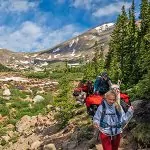 Llama treks are fantastic in August and offer the ability to explore the backcountry of Yellowstone with minimal impact and maximum comfort. Each llama can carry 70 pounds of gear and supplies, so guests get to hike with light day packs. Options range from 3-day trips to 6-day trips and feature waterfalls, wildlife, vast meadows, and stunning scenery. If you’d like to enjoy the benefits of a llama trek but aren’t interested in a fully guided adventure, you can also rent llamas or hire Wildland Llamas to provide a drop camp for you. (Drop camps are a service where the outfitter carries in your supplies and helps set up your camp, but it is not a guided trip.)
Llama treks are fantastic in August and offer the ability to explore the backcountry of Yellowstone with minimal impact and maximum comfort. Each llama can carry 70 pounds of gear and supplies, so guests get to hike with light day packs. Options range from 3-day trips to 6-day trips and feature waterfalls, wildlife, vast meadows, and stunning scenery. If you’d like to enjoy the benefits of a llama trek but aren’t interested in a fully guided adventure, you can also rent llamas or hire Wildland Llamas to provide a drop camp for you. (Drop camps are a service where the outfitter carries in your supplies and helps set up your camp, but it is not a guided trip.)
Many people ask why we use llamas instead of horses or other stock animals on this kind of trek. As it turns out, many people view llamas as better stock animals than horses. This is for a variety of reasons and there are definitely pros and cons to both. The biggest difference is you lead a llama instead of riding it as you would a horse, but many people view this as a pro instead of a con. Llamas have far less impact on the environment, are easier to saddle and unload, are less easily spooked, and have gentler temperaments than horses. Llamas also act as a guard around camp, as large predators such as bears and mountain lions are likely to leave a herd of large, unfamiliar animals alone.
As an added bonus, many hikers say that the llama’s quirky personalities make the animals enjoyable travel companions. On llama treks with Wildland Trekking, you can choose to lead a llama or hike on your own but still benefit from the llama carrying much of your gear. You can read all about hiking with llamas and what your experience might be with these animals.
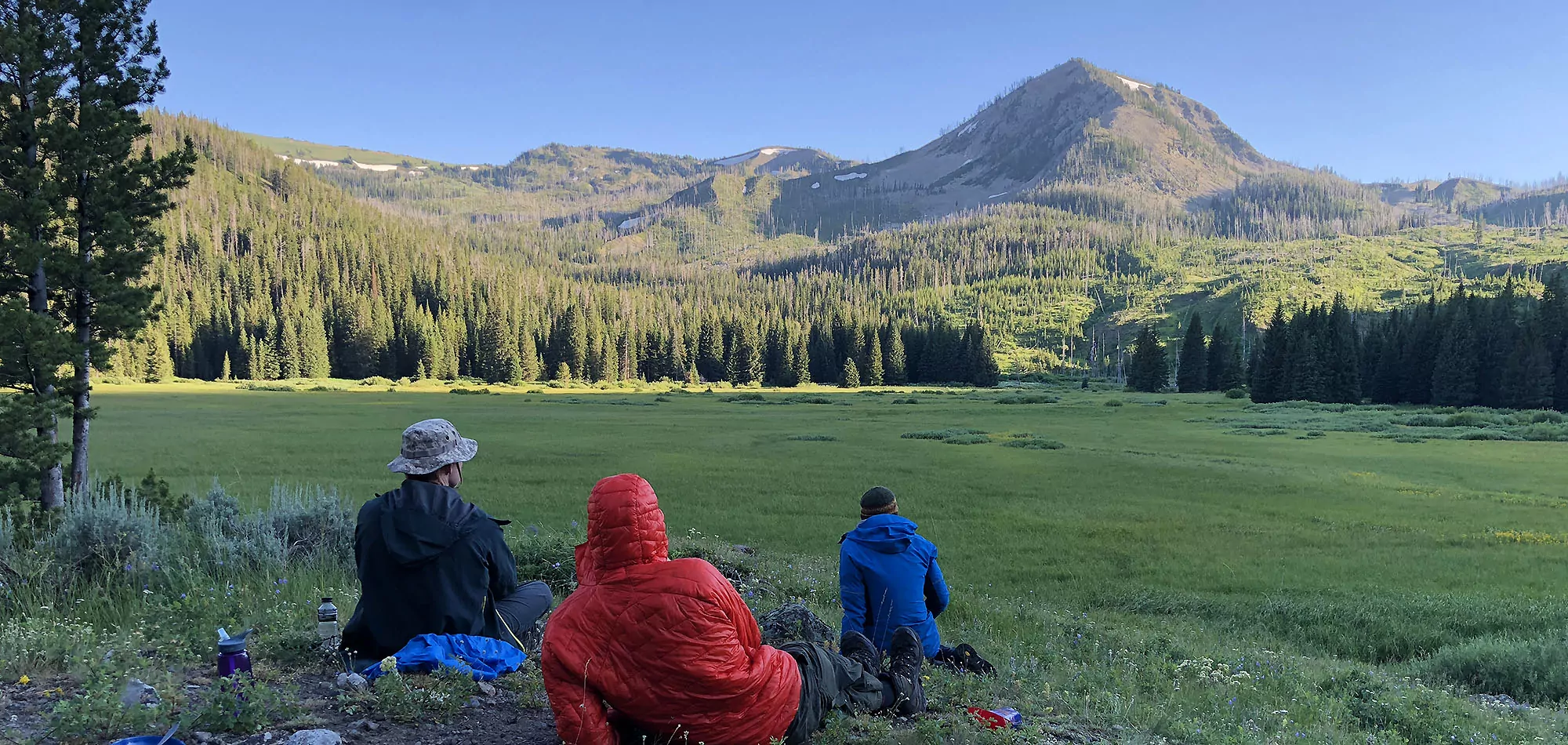
Hiking in August
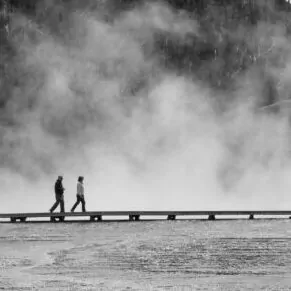 Hiking is wonderful in August, and there are many trails to choose from. With the snow melted from the higher peaks, all of the trails in the park should be open by August, giving you access to over 1000 miles of hiking trails. Before setting out, you can look into the trail conditions, so you know how to prepare.
Hiking is wonderful in August, and there are many trails to choose from. With the snow melted from the higher peaks, all of the trails in the park should be open by August, giving you access to over 1000 miles of hiking trails. Before setting out, you can look into the trail conditions, so you know how to prepare.
There are many options for hiking in Yellowstone from leisurely strolls to strenuous treks. Many of the famous sites such as Old Faithful, Grand Prismatic Spring, and the Grand Canyon of Yellowstone offer short walks that can help you escape some of the crowds. Old Faithful has an extensive boardwalk in the surrounding geyser basin as well as a hike up a short hill that brings you to an overlook where you can see the geyser’s eruption from a different angle–and hopefully with fewer people. Grand Prismatic Spring also offers an overlook trail. If you’re looking to make this hike longer, you can trek up to Fairly Falls which is beyond the overlook. The farther you go, the more the crowds will thin out. Near Canyon Village, the Grand Canyon of Yellowstone offers spectacular hiking options from quiet strolls along the rim to hiking down into the canyon on the 7 Mile Hole trail or the paths that lead down to Red Rock Point or the brink of the lower falls in the canyon. Many of these trails lead past amazing hydrothermal features, stunning overlooks, and many places to view wildlife. Yellowstone Lake also offers boardwalk strolls around hydrothermal areas and lots of lakeside hiking along its shores. You can check out our list of best hikes in Yellowstone for more ideas.
Take proper precautions to make a hike safe, as Yellowstone is the wilderness which comes with a handful of risks and dangers. Bring plenty of water and sun protection and do not approach any wildlife you see. Yellowstone is grizzly bear country, so make sure you know how to use bear safety and what to do if you encounter a bear. It’s always best to hike in groups and to carry bear spray. Bison have injured more people than any other animal in the park– bears included– so keep your distance and never approached them for pictures. Never leave the trail to get closer to geothermal features as people have been severely burned or scalded to death by coming in contact with these boiling waters. Be aware of impending weather, as the afternoon thundershowers can come up quickly.
Backpacking in August
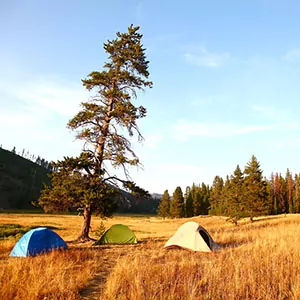
August is the perfect time of year for backpacking since the snow has melted. Backcountry permits may be difficult to obtain because of the crowds, but as long as you are flexible with your itinerary and plan in advance, you should be able to get the route you desire. Consider going with a guiding company—the company takes care of all the logistics and permits, so all you have to worry about is enjoying the scenery around you.
With so many hundreds of miles of trails available to you, there seem to be truly no end of options for where to go. You can make your trek anything from a single-night weekend getaway to a long trip in the backcountry. Not only does a backpack get you away from many of the crowds, but it also allows you to see sights and wildlife that those who only drive around the park could only dream of. A rather popular option is a backpacking trip from Heart Lake to Snake River that includes geothermal vents without the boardwalk or the crowds, gorgeous lakeside camping, great opportunities to see wildlife, and of course the majestic snake river. This can be done in either four or five days as you can take a layover day if you’d like, to just relax in the scenery.
Yellowstone’s Thorofare starts from the headwater basin of the Yellowstone River and goes through arguably the most scenic and least visited parts of the park. Backpacking around Shoshone Lake allows visitors the opportunity to see a backcountry lake and a geyser basin on the same trip. The trail can be done as a through hike or a loop in 5 to 6 days beginning at Lonestar Geyser Trailhead. With excellent fishing and swimming (if you don’t mind cold water), many chose to take a layover day without hiking anywhere to enjoy its pristine waters and amazing views.
Of course, backpacking in Yellowstone does come with some hazards. All of the risks that come with day hiking also apply to backpacking, so make sure to read the section above if you’re interested in going backpacking. Camping in bear country can be dangerous and the biggest way to mitigate the danger is proper food storage. Yellowstone has designated backcountry campsites, many of which have food poles to hang your food, though you will have to bring your own rope. Do not approach any wildlife that you see, and make sure to also give bison and elk a wide berth, especially in August and September during their mating season. Mosquitoes and other biting bugs will be out this time of year, so make sure to bring bug spray as well as rain gear as afternoon thundershowers are not uncommon.
Going on a backpacking trip with a guiding company is a great option, especially if you’ve never been backpacking or have never been backpacking in Yellowstone before. They take care of all the logistics and make sure to brief you on safety measures before your trip, so you can relax and know you’re not missing any crucial safety information.
Weather in August
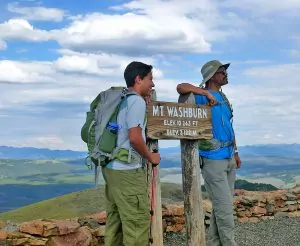 Yellowstone is a large park with elevations ranging from 6,000 to 11,00 ft, so the weather you encounter will depend greatly on where you are and what elevation you are at. Higher elevations tend to be cooler, with more chance of rain while lower elevations are typically warm and dry. The weather in Yellowstone in August is usually hot during the day and cooler in the evening. The average temperature for Mammoth Hot Springs is a high of 79, and a low of 47 degrees Fahrenheit (26/ 8 degrees Celsius). At Yellowstone Lake, the average temperature is a high of 70, and a low of 38 degrees Fahrenheit (21/ 3 degrees Celsius). On average, there are 5 days of rain in August.
Yellowstone is a large park with elevations ranging from 6,000 to 11,00 ft, so the weather you encounter will depend greatly on where you are and what elevation you are at. Higher elevations tend to be cooler, with more chance of rain while lower elevations are typically warm and dry. The weather in Yellowstone in August is usually hot during the day and cooler in the evening. The average temperature for Mammoth Hot Springs is a high of 79, and a low of 47 degrees Fahrenheit (26/ 8 degrees Celsius). At Yellowstone Lake, the average temperature is a high of 70, and a low of 38 degrees Fahrenheit (21/ 3 degrees Celsius). On average, there are 5 days of rain in August.
Many people would consider these evening temperatures downright cold, so it is best to bring some warm layers and a jacket for the evenings, even if you’re not planning on being out very much after dark. Visitors should be prepared for the worst they might encounter, so make sure to bring rain gear even if you don’t think you’ll have to use it. Yellowstone is also known for its high winds, and a good rain jacket will keep the wind off you. Guests should also be aware that because Yellowstone is in the mountains and at high elevations, the air is very dry with little or no humidity. Those from coastal areas or from areas where humidity comes with heat, such as the American South, should bring lots of lotion and be prepared for possibly dry and cracking skin on your hands and feet. Yellowstone’s elevation can also cause visitors trouble, as hikes and activities that you would be able to do easily at home will quickly make you out of breath. If you’re staying for more than two or three days, you should acclimate to the elevation, but make sure to take it easy and not push yourself too hard. If you’re staying above 8000 feet for any period of time, usually on a backpacking trip, make sure you know the symptoms of altitude sickness and what to do if you are one of the members of your party experiencing these symptoms.
Wildlife in August
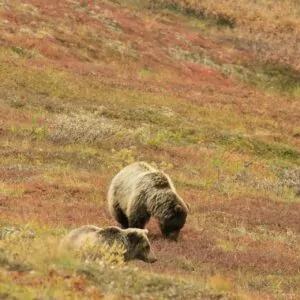 Wildlife viewing is fantastic in Yellowstone in August. The biggest benefit of this month is the beginning of the rut, bison, and elk mating season. Both species have specific rituals that are a treat for visitors to see.
Wildlife viewing is fantastic in Yellowstone in August. The biggest benefit of this month is the beginning of the rut, bison, and elk mating season. Both species have specific rituals that are a treat for visitors to see.
The elk gather near Mammoth Hot Springs and form small harems of 10 to 30 females with one dominant male. Other males may challenge the dominant male of the harem, and bull elk can often be seen tussling with their antlers interlocked, fighting for the right to mate. This is also the time of year when you can hear the classic elk bugle, which begins as a high-pitched whistle and can end in a low–almost barking– sound. These calls echo off the mountainsides and can be heard miles away. In contrast to elk, bison form very large herds during the mating season, with many males and females together in the Lamar and Hayden Valleys.
Bull bison can be seen fighting as bull elk do with their horns. The winning bull will take a female away from the herd for as little as a few minutes or as long as a few days to mate before returning to the herd. The dust that is stirred up from these fights has been reported to cause visibility issues, as at times visitors drive through these valleys and see nothing but large dust clouds. But there is more to the wildlife in Yellowstone in August than bison and elk.
Both black bears and grizzly bears are active this time of year and can often be seen along the side of the roads. Many members of the weasel family also called this park their home, such as otters, beavers, weasels, badgers, and martens. Many birds also inhabit the park in the numerous waterways and rivers. Golden eagles, trumpeter swans, and common loons are all sought-after sightings. Yellowstone is home to the highest concentration of mammals in the lower 48 states, including many elusive creatures that are rarely seen by visitors. Mountain lions, Canada lynx, bobcats, and wolverines all remain in the high country for the summer for the cooler temperatures and to avoid the influx of people. Yellowstone gray wolves, a very sought-after wildlife sighting, are less likely to be seen in summer due to the warmer temperatures. They will typically stay in the high country until September or when the temperature begins to drop, although it is not impossible to see a pack roaming through the Lamar or Hayden Valleys near dawn or dusk.
Recommended Wildland trips in august
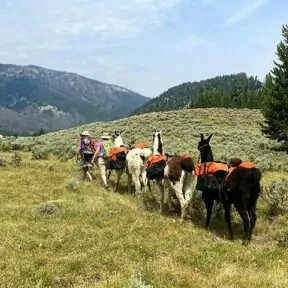 Planning a trip to Yellowstone in August can be overwhelming as you try to keep up with the accommodation rates, things to do, and how to avoid the large crowds. But you can bypass all the headaches by booking a trip with Wildland Trekking and letting one of our expert guides show you around the park. We offer a variety of trips with a variety of difficulty levels. From backpacking and llama treks to inn based trips and base camp tours, we guarantee that there is something for you. Feel free to browse all the trips for the offer in Yellowstone, but here are a few especially recommend for August.
Planning a trip to Yellowstone in August can be overwhelming as you try to keep up with the accommodation rates, things to do, and how to avoid the large crowds. But you can bypass all the headaches by booking a trip with Wildland Trekking and letting one of our expert guides show you around the park. We offer a variety of trips with a variety of difficulty levels. From backpacking and llama treks to inn based trips and base camp tours, we guarantee that there is something for you. Feel free to browse all the trips for the offer in Yellowstone, but here are a few especially recommend for August.
Sportsman Lake Llama Trek: Set out with llama companions and only a light day pack on this five-day trip into the Gallatin mountain range in Yellowstone. We’ll trek through pristine meadows and along the side of gorgeous lakes before summiting Gallatin Mountain’s highest summit, Electric Peak, which is over 11,000 ft. If you don’t want to summit, that’s ok too and you’ll have plenty of opportunity for amazing views at the lower electric pass. All-inclusive with much of your gear, meals, and local transportation included, you won’t want to miss this fantastic Yellowstone adventure.
Observation Peak Trek: If you want to get out in the backcountry, but want to make sure that the hiking distances are reasonable and that your pack isn’t too heavy, this is the trip for you. This 2 to 3-day backpacking trip will take you to some of Yellowstone’s most pristine areas near Cascade Lake and up to a historic fire lookout. With shorter hiking distances and a relaxed tone, this all-inclusive backpacking trip is sure to make you want to come back for more in Yellowstone’s backcountry.
Yellowstone Hiking Experience: With the perfect combination of spectacular hiking in the wilderness and cozy accommodations, this three-day inn-based tour gives you the best of both worlds. Each day you’ll embark on unique day hikes in Yellowstone with the possibility to see amazing wildlife before returning in the evening to your cozy, National Park lodge accommodations. All-inclusive with your local transportation, lodging, meals, and much of your gear included, this is a great trip to just get your feet wet in Yellowstone and see what you want to do when you come back.
Join a Guided Hiking Adventure
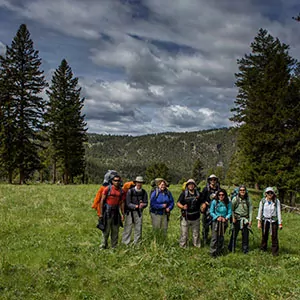 Yellowstone National Park is home to some of the most epic and amazing hiking vacations in the world. Wildland Trekking offers trips with the best of Yellowstone: geysers, waterfalls, views, wildlife, solitude, adventure, and fascinating natural and cultural interpretation.
Yellowstone National Park is home to some of the most epic and amazing hiking vacations in the world. Wildland Trekking offers trips with the best of Yellowstone: geysers, waterfalls, views, wildlife, solitude, adventure, and fascinating natural and cultural interpretation.
Guided Yellowstone treks are all-inclusive which covers permits; local transportation (excluded on certain tours); meals; equipment; safety systems and professional hiking/wilderness guides; all of which allow visitors to maximize their time in Yellowstone and focus entirely on enjoying the Park.
YELLOWSTONE ADVENTURE TOURS
- GUIDED BACKPACKING ADVENTURES: these are for people interested in an authentic Yellowstone adventure away from the roads and crowds.
- LLAMA TREKS: on these innovative trips, guests hike with light day packs and camp near stunning backcountry locations.
- INN-BASED PACKAGES: these tours are all-inclusive packages with lodging, amazing daily hikes, expert guides, meals, transportation, and more!
- CAMPING-BASED HIKING PACKAGES: camping-based hiking packages provide all-around hiking experiences of Yellowstone on wonderful outdoor vacations.
- DAY HIKE TOURS: maximize your day in Yellowstone on a fully guided, award-winning hiking tour on one of the Park’s best trails.





